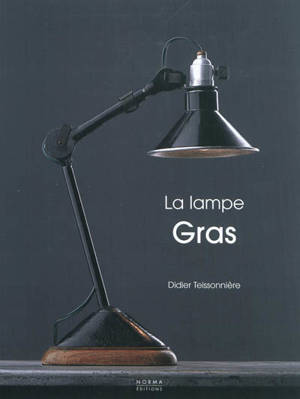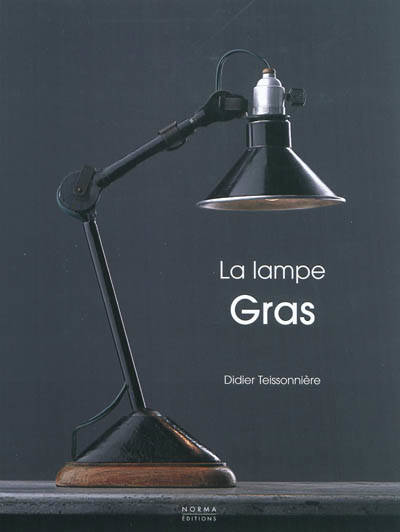
Door een staking bij bpost kan je online bestelling op dit moment iets langer onderweg zijn dan voorzien. Dringend iets nodig? Onze winkels ontvangen jou met open armen!
- Afhalen na 1 uur in een winkel met voorraad
- Gratis thuislevering in België vanaf € 30
- Ruim aanbod met 7 miljoen producten
Door een staking bij bpost kan je online bestelling op dit moment iets langer onderweg zijn dan voorzien. Dringend iets nodig? Onze winkels ontvangen jou met open armen!
- Afhalen na 1 uur in een winkel met voorraad
- Gratis thuislevering in België vanaf € 30
- Ruim aanbod met 7 miljoen producten
Zoeken
Omschrijving
La lampe Gras a une place inédite dans l’histoire du luminaire. Conçue et fabriquée en 1921, elle inaugure un genre nouveau le système d’éclairage dont la vocation est de satisfaire aussi bien le monde de l’industrie que le secteur tertiaire en plein essor.
À géométrie variable et aisément adaptable au gré des besoins de chacun, la lampe Gras est à même d’éclairer de la façon la plus performante les machines-outils, les planches à dessin, les bureaux, les laboratoires et jusqu’au bloc opératoire du paquebot Normandie. Répudiant tout maniérisme ornemental, son créateur, l’ingénieur Bernard-Albin Gras, l’a dotée d’une esthétique relevant de cette adéquation parfaite du dessein, et du dessin qui fonde ce qu’on appelle aujourd’hui le design.
Comme telle, son succès fut immédiat, au point de susciter interprétations et imitations, notamment chez les membres du Bauhaus fascinés par cet incunable de la modernité. Mais il revient à Le Corbusier de lui avoir conféré une aura particulière, voyant en elle, selon ses propres termes un « objet-outil » réduit à sa pure fonctionnalité, un « objet-type » dont il a fait bénéficier son agence comme ses réalisations architecturales. À sa suite, Robert Mallet-Stevens, Eileen Gray, Michel Roux-Spitz, Sonia Delaunay, Georges Braque et tant d’autres figures de l’avant-garde l’ont adoptée, contribuant à a faire entrer dans la légende. Cette carrière prestigieuse se double d’un succès plus anonyme dans le monde du travail, exceptionnel par le volume de ses commandes comme par sa durée. Il n’est guère d’autre exemple de lampe qui, sans modification majeure, ait été éditée pendant plus d’un demi-siècle.
Après quelques décennies d’éclipse, la lampe Gras retrouve une notoriété auprès d’une nouvelle génération d’architecte, de décorateurs et de collectionneurs, fascinés par cet objet de la première modernité au même titre que les meubles de Le Corbusier, Herbst, Prouvé et Perriand. Cet ouvrage retrace l’histoire d’une invention et d’une aventure industrielle mais il se veut aussi une promenade à travers les choix esthétiques de l’entre-deux guerre et ceux, plus éclectiques, du temps présent.
À géométrie variable et aisément adaptable au gré des besoins de chacun, la lampe Gras est à même d’éclairer de la façon la plus performante les machines-outils, les planches à dessin, les bureaux, les laboratoires et jusqu’au bloc opératoire du paquebot Normandie. Répudiant tout maniérisme ornemental, son créateur, l’ingénieur Bernard-Albin Gras, l’a dotée d’une esthétique relevant de cette adéquation parfaite du dessein, et du dessin qui fonde ce qu’on appelle aujourd’hui le design.
Comme telle, son succès fut immédiat, au point de susciter interprétations et imitations, notamment chez les membres du Bauhaus fascinés par cet incunable de la modernité. Mais il revient à Le Corbusier de lui avoir conféré une aura particulière, voyant en elle, selon ses propres termes un « objet-outil » réduit à sa pure fonctionnalité, un « objet-type » dont il a fait bénéficier son agence comme ses réalisations architecturales. À sa suite, Robert Mallet-Stevens, Eileen Gray, Michel Roux-Spitz, Sonia Delaunay, Georges Braque et tant d’autres figures de l’avant-garde l’ont adoptée, contribuant à a faire entrer dans la légende. Cette carrière prestigieuse se double d’un succès plus anonyme dans le monde du travail, exceptionnel par le volume de ses commandes comme par sa durée. Il n’est guère d’autre exemple de lampe qui, sans modification majeure, ait été éditée pendant plus d’un demi-siècle.
Après quelques décennies d’éclipse, la lampe Gras retrouve une notoriété auprès d’une nouvelle génération d’architecte, de décorateurs et de collectionneurs, fascinés par cet objet de la première modernité au même titre que les meubles de Le Corbusier, Herbst, Prouvé et Perriand. Cet ouvrage retrace l’histoire d’une invention et d’une aventure industrielle mais il se veut aussi une promenade à travers les choix esthétiques de l’entre-deux guerre et ceux, plus éclectiques, du temps présent.
Specificaties
Betrokkenen
- Auteur(s):
- Uitgeverij:
Inhoud
- Aantal bladzijden:
- 223
- Taal:
- Frans
Eigenschappen
- Productcode (EAN):
- 9782915542448
- Verschijningsdatum:
- 8/03/2012
- Uitvoering:
- Hardcover
- Afmetingen:
- 240 mm x 320 mm
- Gewicht:
- 1580 g

Alleen bij Standaard Boekhandel
+ 118 punten op je klantenkaart van Standaard Boekhandel
Beoordelingen
We publiceren alleen reviews die voldoen aan de voorwaarden voor reviews. Bekijk onze voorwaarden voor reviews.











